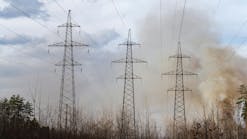The primary cause of pole fires that lead to wildfires is current leakage from insulating equipment. When you dig a little deeper, this seemingly simple explanation starts to get very interesting. The process from initial current leakage to ignition takes time — weeks, sometimes many months, and the process will probably surprise you.
It begins when contaminants adhere to the surface of overhead equipment. Moisture is the catalyst. It could be fog, drizzle, rain, or even bird residue, but when any kind of moisture combines with the dirt, salt, dust, or other contaminant present on insulator surface, a dry band can begin to form. This dry band becomes a conduit for current – a well-defined pathway for electricity to flow across the surface of the insulating device into the wooden crossarms. Over time, the wood dries out. The current flowing to ground heats up the metal king bolt that connects the crossarm to the pole. The combination of hot metal and dry wood eventually ignites causing the pole fire or hot embers that can fall to the ground, which in turn can cause a wildfire. Surprisingly, it only requires a light current flow of just 4 to 5mA to begin the process and create a devastating fire. And the older the pole, the quicker it will happen.
Eventually, rain will wash away the contaminant, but here’s what most people don’t realize: despite the contaminant presence washing off the surface, the dry bands often remain. They may diminish without moisture, but they do not go away. They stay there and are basically “shorting” those portions of the insulator surface. It’s the shorting on the surface that creates an opportunity for increased leakage current. In fact, the presence of dry bands can cause the leakage current and lead to a flashover event and a power outage. Without removing the affected insulator, it continues to be a threat for damaging leakage currents and flashover -- even during dry conditions.
Some have suggested this is a carbon tracking issue on the insulator. While it’s similar, there is no tracking. There is no surface arcing that can be detected visually. This lower impedance part of the insulator surface created by the dry bands concentrates the electrical field across the insulator instead of being evenly dispersed across the entire surface. It’s the area around the dry band deposition that becomes electrically active – eventually resulting in a flashover or pole fire.
Exacter has spent extensive time at the Ohio State University High Voltage Laboratory conducting experiments on the effects of dry band arcing, scintillation, and insulator flashover. During these experiments, the researchers noted steam rise from where the moisture is literally drying the contaminant, adhering it to the surface. Studies have been done in the industry where they can literally tell you how many dry bands would be required to create a flashover event and the number of dry bands necessary to continue current leakage.
Grounding and bonding have been used to combat the broad issue of pole fires with marginal success. Power washing insulators is one solution, but this process does not always remove the dry bands. Clearly, the key to preventing pole fires is the early identification of current leakage from overhead components. The good news is that the insulators with dry bands can be identified by their characteristic radio frequency emissions.
Removing and replacing the arcing insulator is the cost-effective course of action to eliminate the threat.This slide show goes over the "anatomy of a pole fire...."








